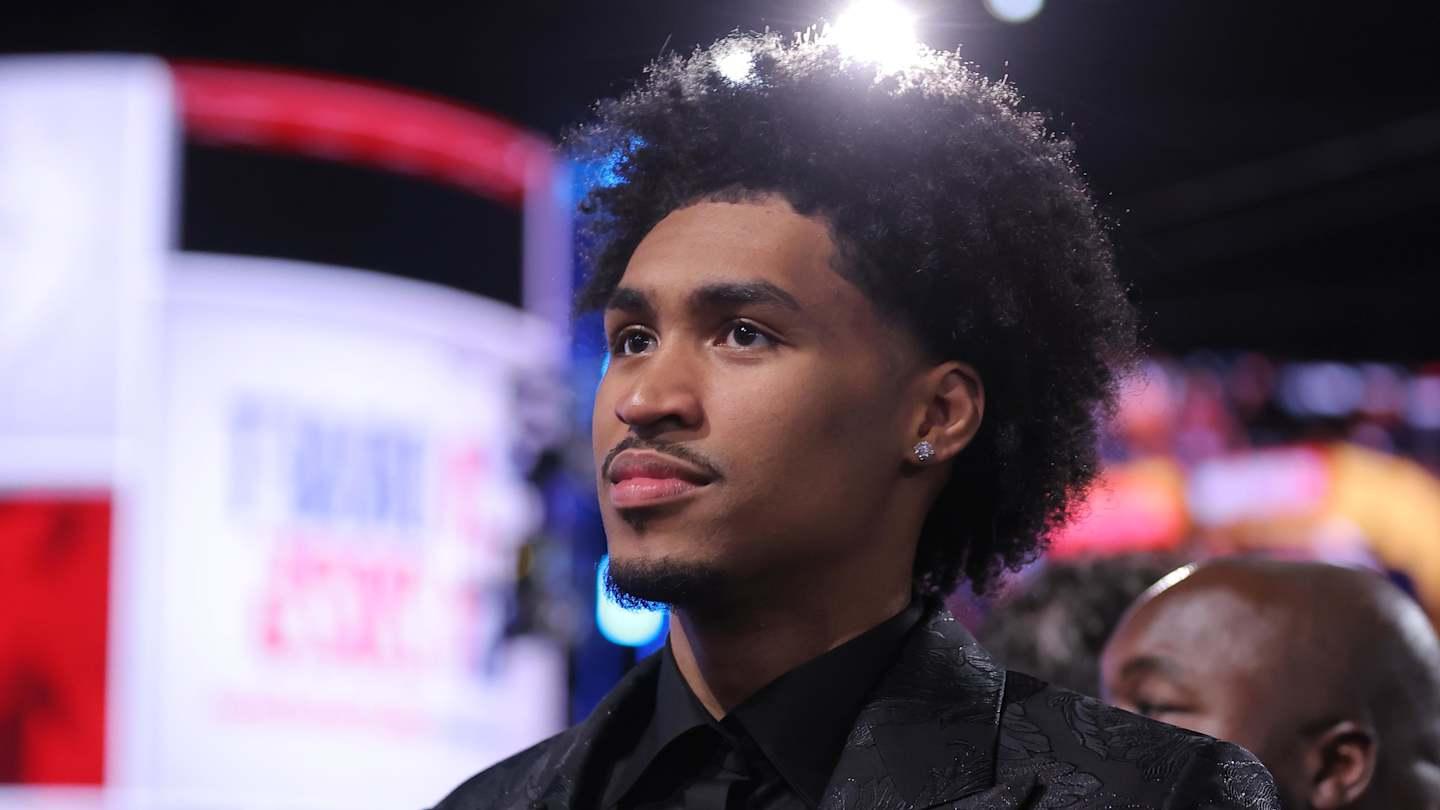Reflections on the highs and lows (excluding Cooper Flagg) from the initial round of the 2025 NBA draft…
- I appreciated San Antonio’s decision to stick with their second overall pick and select Dylan Harper. The Spurs might have felt the urge to make a bold move, especially with Jaylen Brown somewhat available from Boston, provided a stunning offer was made. However, they chose Harper, a guard with potential to be a cornerstone, whom they might still trade should an opportunity to acquire a superstar arise.
- I wasn’t pleased with Philadelphia’s choice of VJ Edgecombe at No. 3. My feelings on Edgecombe are mixed; while he’s a vigorous defender and athletic, his offensive potential doesn’t excite me. His shooting at Baylor was mediocre, and his ability to create shots seemed lacking. For the Sixers, he doesn’t seem to address an immediate need. I’m somewhat taken aback that Daryl Morey didn’t trade the pick for a more seasoned NBA player.
- I liked Utah’s choice of Ace Bailey at No. 5. Bailey’s draft process was unusual with no workouts, reportedly hoping to be picked by either Washington or Brooklyn. However, Utah, in need of top-tier talent, selected him unexpectedly. This bold move is reminiscent of Danny Ainge’s decision to draft Jayson Tatum in 2017 despite Tatum’s reluctance, which ultimately proved successful.
- I was unimpressed with Phoenix’s actions. They chose Khaman Maluach at No. 10, a decision I find underwhelming. Post-draft, there were rumors of Phoenix exploring trade options for Maluach.
TubiTV Just Hit 200 Million Users – Here’s Why
10 Perfect-Score Shows Buried on Prime Video Right Now
Phoenix also made a questionable trade with Charlotte, acquiring Mark Williams in exchange for the 29th pick of this draft and a future first in 2029. It’s puzzling to see them draft Maluach and then trade for Williams, creating an overstaffed center position including Williams, Maluach, Nick Richards, and Oso Ighodaro.
There’s a clear disconnect in Phoenix’s understanding of their team status. They appear to believe they’re a playoff contender capable of restructuring around Devin Booker and a few dynamic centers to secure a playoff spot. However, they are more likely an awkwardly assembled team that will struggle even to make a play-in spot.
- The sight of Yang Hansen, the Chinese 7-footer, being chosen by the Blazers and approaching the stage in his cream white suit was a spectacle. While I don’t necessarily like the pick, considering Portland’s existing roster with Donovan Clingan and others, the moment itself was memorable.
The $3.99 Streaming Service With 500+ Oscar Winners Nobody Knows About
Cancel These 3 Subscriptions Before November 1st – Here’s Why
What are the Blazers planning? Just a year after drafting Clingan, they’ve now picked Yang, who’s nearly 20 with an unrefined offensive skillset. Portland’s assistant general manager, Mike Schmitz, known for his sharp scouting eye, must see potential in Yang that could resemble a modern-day Yao Ming or risk him being a bust like Bruno Caboclo.
- I’m not a fan of some decisions by New Orleans. Their draft week trade, sending CJ McCollum and Kelly Olynyk to Washington in exchange for Jordan Poole and Saddiq Bey, raises questions. Poole’s hefty contract and inefficient play coupled with Bey’s recent injury history seem like risky bets for the Pelicans, sacrificing financial flexibility in hopes Poole can complement Zion Williamson effectively.
On draft night, New Orleans made a solid pick with Jeremiah Fears. Though young, Fears has shown promise, and the Pelicans moved up 10 spots to draft Derik Queen at No. 13. I’m not overly enthusiastic about Queen; he’s inconsistent, not very athletic, and a weak shooter with a slow release, which may not complement Williamson well. These decisions by the Joe Dumars-led front office carry significant risks.
- I applaud Boston’s strategy this week. They managed to offload Jrue Holiday’s remaining three-year contract to Portland and Kristaps Porzingis’s final year to Atlanta. This move significantly reduced their tax liability, possibly freeing them from luxury tax constraints altogether with a few more adjustments. This sets them up well for future flexibility.
Despite a weaker Eastern Conference, the restructured Celtics might face challenges next season. However, escaping the tax burden will provide them opportunities next summer, positioning them well for the 2026–27 season with a solid core of Brown, Jayson Tatum, and Derrick White.
- I’m not in favor of Brooklyn’s decision to use all five of their first-round picks. This unprecedented move saw Egor Demin, Nolan Traore, Drake Powell, Ben Saraf, and Danny Wolf all drafted. It’s unclear if this was the intended strategy or if these players will all appear at training camp, or if another transaction is planned.
- I’m very pleased with Miami selecting Kasparas Jakucionis at No. 20. Jakucionis, who I believe possesses top-five talent, was a surprise at this pick. Despite his tendency for turnovers, his size and playmaking skills are impressive. It’s astonishing he was still available at No. 20, and I foresee him being a remarkable draft steal.
- I was not impressed with ESPN’s draft coverage. Following Utah’s selection of Bailey, the network consulted Jonathan Givony who mentioned that Utah was not among Bailey’s preferred teams. They then turned to Bobby Marks for further analysis on drafting a player seemingly reluctant to join the team. While the coverage was good, it was too limited. ESPN often underuses its experts. A more ideal panel would have included Givony, Marks, and Bob Myers, with Malika Andrews leading the discussion. Their current approach invites valid criticism.
It was good, but there simply wasn’t enough of it. ESPN tends to not fully utilize its experts, which could have made the draft coverage more insightful. An optimal panel would have featured Givony, Marks, and Myers, with Andrews orchestrating the discussion. By not doing so, ESPN opens itself to warranted critique.
More NBA draft on Sports Illustrated
feed
Similar posts:
- NBA Draft Shocker: Ace Bailey’s Surprise Team, Nets Score Five First-Round Picks!
- Derik Queen Aims to Prove Pelicans Exec a ‘Genius’ After Controversial Draft Trade
- NBA Trade Tracker: Latest Draft Deals, Free Agency Buzz & More!
- NBA Draft Drama: Where Will Ace Bailey Land? Top Teams to Watch!
- Pelicans Star Derik Queen Sidelined for Months Due to Major Ligament Tear!

Mike Johnson is a passionate news writer with a keen interest in current events. With over a decade of experience in journalism, he has a talent for uncovering the stories that matter most. Mike’s insightful articles and in-depth analyses have made him a trusted voice in the industry. He thrives on staying ahead of the news curve, providing readers with timely and relevant information. Whether it’s breaking news, politics, or social issues, Mike’s dedication to the craft ensures that his readers are always well-informed.

